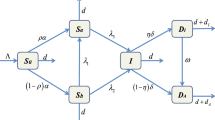Abstract
An AIDS model with distributed incubation and variable infectiousness is considered and simulated via a second-order numerical method. The method is applied to the HIV epidemic among IV drug users in the Latium region of Italy, using available data on the lenght of the incubation period before the onset of AIDS, on the infectivity of infected individuals during that period, and on the demography of drug users. The contact rate is adjusted to match the actual number of AIDS cases. The sensitivity of the model to uncertainties in the parameters is finally investigated, by performing several simulations.
Similar content being viewed by others
References
Anderson R.M., Medley G.F., May R.M. and Johnson A.M. (1986): A Preliminary Study of the Transmission Dynamics of the Human Immunodeficiency Virus (HIV), the Causative Agent of AIDS, IMA Journal of Mathematics Applied in Medicine & Biology 3: 229–263.
ArcàM., PerucciC.A., Spadea T. and Rossi C. (1990): A multipopulation model of HIV epidemics in Latium, Italy. - Abstract FC 223. Sixth International Conference on AIDS, San Francisco.
Bacchetti P. and Moss A.R. (1989): Incubation period of AIDS in San Francisco - Nature 338: 251–253.
Blythe S.P. and Anderson R.M. (1988): Variable infectiousness in HIV Transmission Models - IMA Journal of Mathematics Applied in Medicine & Biology 5: 181–200.
Bortolotti F., Stivanello A., Dall'Armi A., Rinaldi R. and LaGrasta F. (1988): AIDS information campaign has significantly reduced risk factors for HIV infection in Italian drug abusers, - J. of AIDS 1: 412–413.
Castillo-Chavez C., Cooke K., Huang W. and Levin S.A. (1989): On the role of long incubation periods in the dynamics of acquired immunodeficiency syndrome (AIDS). 1. Single population models - J. Math. Biol. 27: 373–398.
DeGruttola V. and Lagakos S.W. (1989): Analysis of Doubly Censored Survival Data, with application to AIDS, in Mathematical and statistical approaches to AIDS epidemiology, C. Castillo-Chavez (ed.), pp. 38–57- Lecture Notes in Biomathematics 83, Springer-Verlag, Berlin.
Donoghoe M. C., Dolan K.A. and Stimson G.V. (1991): Changes in injectors' HIV risk behaviour and syringe supply in UK 1987–90 - Abstract Th.C. 45. Seventh International Conference on AIDS, Florence.
Friedman S.R., DesJarlais D.C., Neaigus A., Abdul-Quader A., Sotheran J.L., Sufian M., Tross S. and Goldsmith D. (1989): AIDS and the new druginjector- Nature 339: 333–334.
Galli M., Lazzarin A. and Rezza G. (1988): L'AIDS in Italia - Le Science 244: 70–78.
Huang W., Castillo-Chavez C., Cooke K.L. and Levin S.A. (1989): On the role of long incubation periods in the dynamics of acquired immunodeficiency syndrome (AIDS). Part 2: Multiple group models, in Mathematical and statistical approaches to AIDS epidemiology, C. Castillo-Chavez (ed.), pp. 200–217 -Lecture Notes in Biomathematics 83, SpringerVerlag, Berlin.
Imagawa D.T., Lee M.H., Wolinsky S.M., Sano K., Morales F., Kwok S., Sninsky J.J., Nishanian P.G., Giorgi J., Fahey J.L., Dudley J., Visscher B.R. and Detels R. (1989): Human immunodeficiency virus type 1 infection in homosexual men who remain seronegative for prolonged periods - New England J. Medicine 320: 1458–1462.
Jacquez J.A., Simon C.P., Koopman J., Sattenspiel L. and Perry T. (1988): Modeling and analyzing HIV transmission: the effect of contact patterns - Math. Biosc. 92: 119–199.
Lui K.J., Lawrence D.N. and Morgan W.M. (1986): A model-based approach for mean incubation period of transfusion-associated acquired immunodeficiency syndrome - Proc. Natl. Acad. Science USA 83: 3051–3055.
Medley G.F., Anderson R.M., Cox D.R. and Billard L. (1987): Incubation period of AIDS in patients infected via blood transfusion - Nature 328: 719–721.
Padian N., Marquis L., Francis D.P., Anderson R.E., Rutherford G.W., O'Malley P.M. and Winkelstein W. Jr. (1987): Male-to-female transmission of human immunodeficiency virus - J. Amer. Med. Ass. 258: 788–790.
Padian N.S., Shiboski S.C. and Jewell N.P. (1990): The effect of the number of exposures on the risk of heterosexual HIV transmission - J. of Infectious Diseases 161: 883–887.
Pedersen C., Nielsen C.M., Vestergaard B.F., Gersfoft J., Krogsgaard K. and Nielsen J.E. (1987): Temporal relation of antigenaemia and loss of antibodies to core antigens to development of clinical disease in HIV infection - Br. Med. J. 295: 567–572.
Perucci C.A., Davoli M., Rapiti E., Abeni D. and Forastiere F. (1991): Mortality of intravenous drug users in Rome: a cohort study - Amer. J. Publ. Health 81: 1307–1310.
Perucci CA., Arca M., Michelozzi P. and the Unità Operativa AIDS dell'O.E.R. (1990): Epidemia di infezione da HIV e di AIDS nel Lazio - Progetto Salute 15.
Peterman T.A., Stoneburner R.L., Allen J.R., Jaffe H.W. and Curran J.W. Risk of human immunodeficiency virus transmission from heterosexual adults with transfusion-associated infections - J. Amer. Med. Ass. 259: 55–58.
Rees M. (1987): The sombre view of AIDS - Nature 326: 343–345.
Rezza G., Titti F., Tempestae, DiGiannantonio M., Welsert A., Rossi G.B. and Verani P. (1989): Needle sharing and other behaviours related to HIV spread among intravenous drug users - AIDS 3: 247–248.
Salmaso S., Fiume A., Forastiere F., Sasse H., Perucci C., Anemona A., Zampieri F., Brancato G., Abeni D. and Rezza G. (1991): In - and out of- treatment drug users in Italy: sexual and drug-related behaviors -Abstract W.C. 3342. Seventh International Conference on AIDS, Florence.
Taylor J.M.G., Schwartz K. and Detels R. (1986): The time from infection with human immunodeficiency virus (HIV) to the onset of AIDS - J. Infect. Disease 154: 694–696.
Thieme H.R. and Castillo-Chavez C. (1989): on the role of variable infectivity in the dynamics of the human immunodeficiency virus epidemic, in Mathematical and statistical approaches to AIDS epidemiology, C. Castillo-Chavez (ed.), pp. 157–176 -Lecture Notes in Biomathematics 83, Springer.
Arcà M., Perucci C.A. and Spadea T. (1982): The epidemic dynamics of HIV-1 in Italy. Modelling the interaction between intravenous drug users and heterosexual population - Statistic in Medicine, in press.
Author information
Authors and Affiliations
Rights and permissions
About this article
Cite this article
Iannelli, M., Loro, R., Milner, F. et al. An AIDS model with distributed incubation and variable infectiousness: Applications to IV drug users in Latium, Italy. Eur J Epidemiol 8, 585–593 (1992). https://doi.org/10.1007/BF00146381
Issue Date:
DOI: https://doi.org/10.1007/BF00146381




